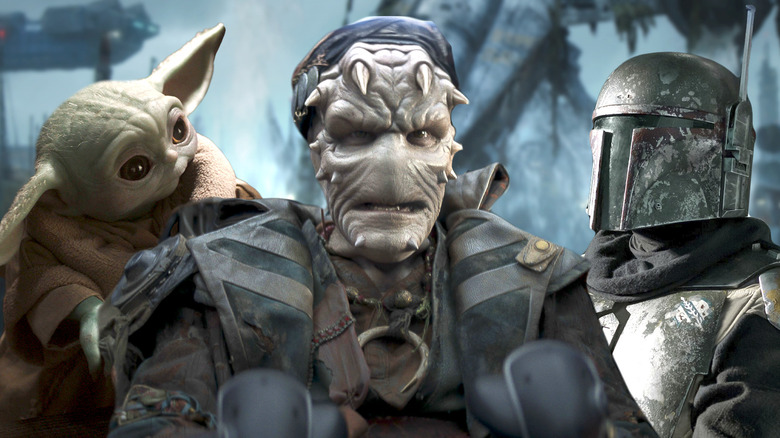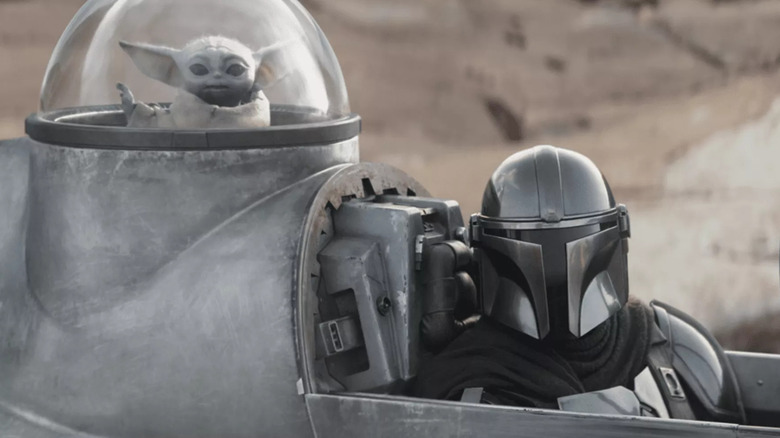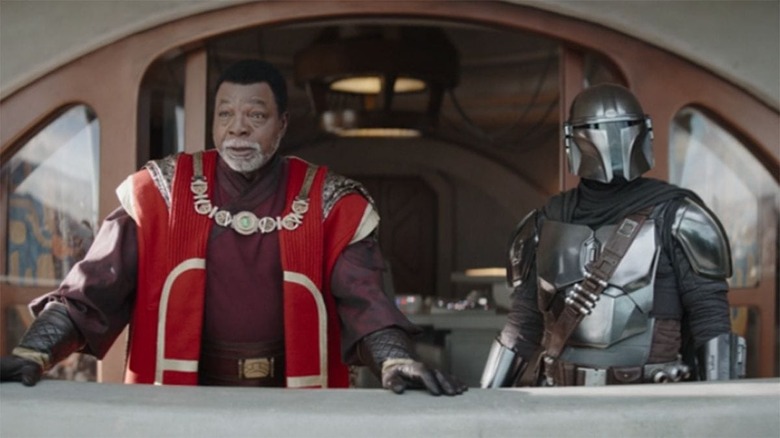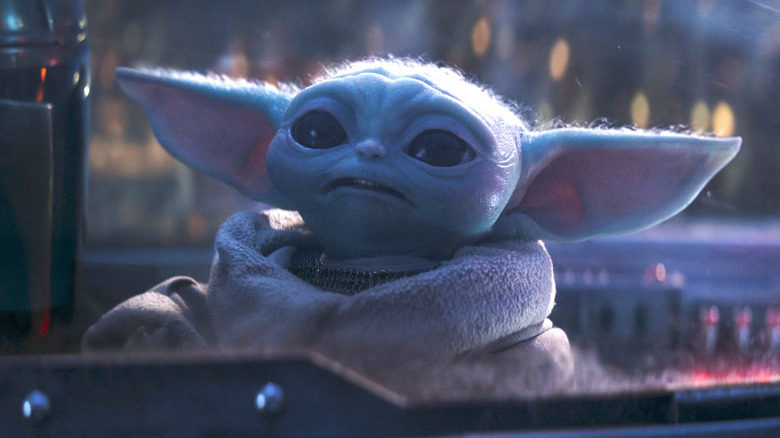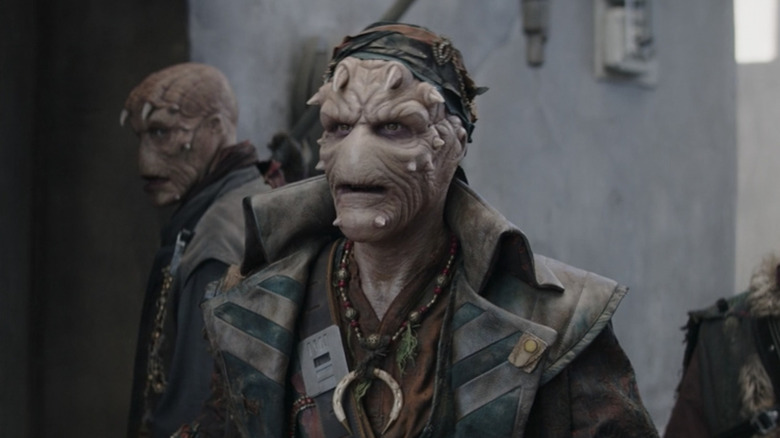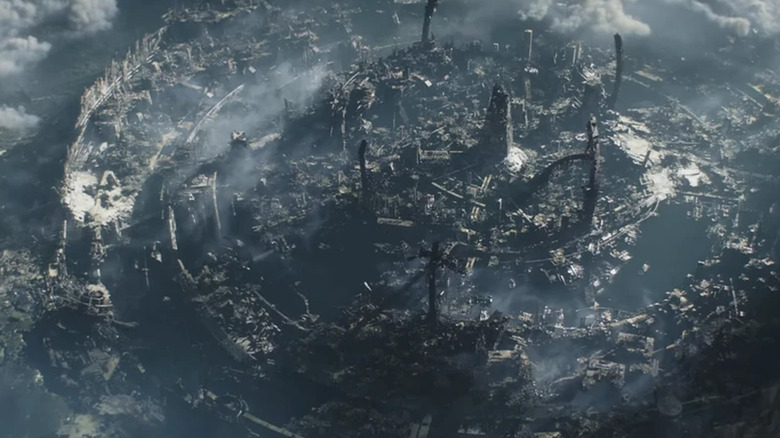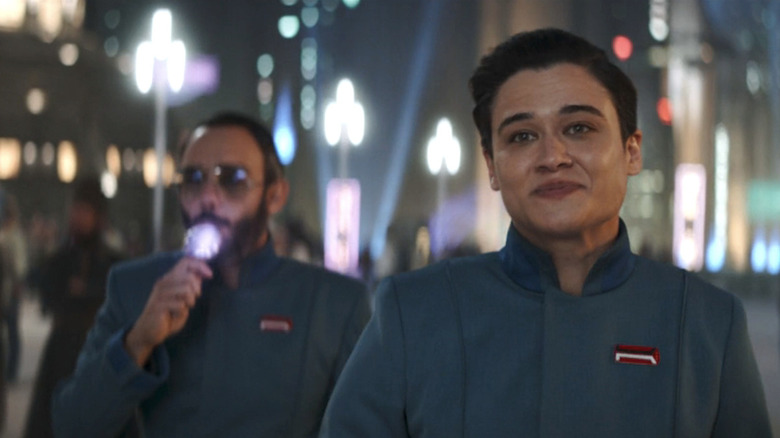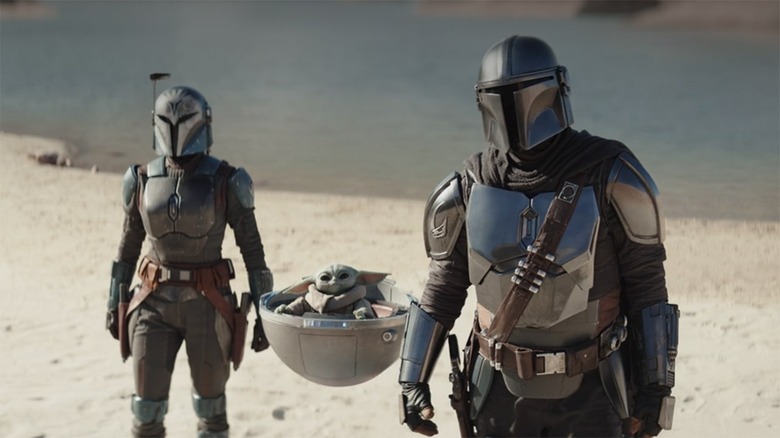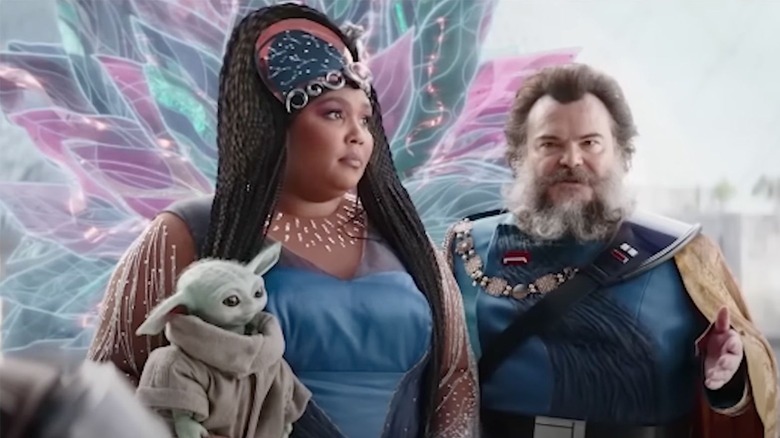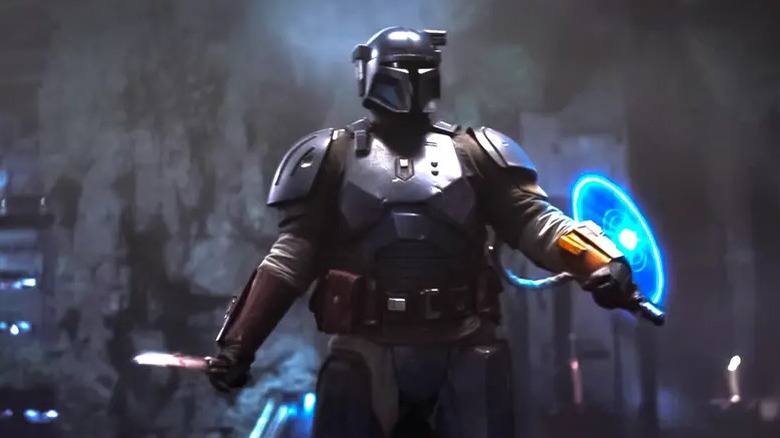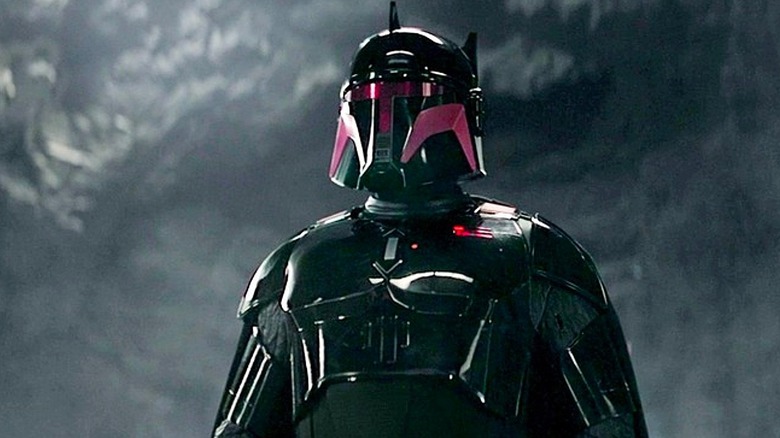Things In The Mandalorian Season 3 That Upset Fans The Most
"The Mandalorian" Season 3 is behind us, but the hot takes continue on. What was once Disney+'s juggernaut of a show, almost universally beloved by the "Star Wars" fan base, hit audiences a little differently in its third go-round. Tarnished somewhat by the lackluster interconnected spin-off "The Book of Boba Fett" and having to follow a rapturously received and much more sophisticated Season 1 of "Andor," "The Mandalorian" suddenly seems a little meh. Ratings and reviews were down, and the series just wasn't the main topic in the zeitgeist as it had been in Seasons 1 and 2.
"Star Wars" fans are known for being hard on the saga they love, and since they loved "The Mandalorian" so much upon its premiere back in 2019, they were eager to let studios and showrunners know what wasn't working in 2023. Some of the complaints are nitpicks. And not every corner of the fandom shares every sour opinion. But some of the criticisms are fair and underline problems that have plagued "Star Wars" for decades. These are the reasons that fans of "The Mandalorian" struggled a bit more than usual to make it through Season 3.
Mandatory Book of Boba Fett viewing
"The Mandalorian" Season 3 was at an almost insurmountable disadvantage before a single episode even aired. At the end of Season 2, Din Djarin gives Grogu to Luke Skywalker for training. He believes he's doing right by the little potential Jedi, though he's clearly sad to say goodbye. Curiously, in the premiere episode of Season 3, Din Djarin and Grogu are back together without explanation. Fans who'd tuned into "The Book of Boba Fett" knew how their story resolved within the final chapters of that seven-episode miniseries. But not everyone who watches "The Mandalorian" hung around for "The Book of Boba Fett." And even some of those who did were annoyed by the decision to include such a pivotal plot point in the arc of another show.
Disney and Lucasfilm could've mitigated this complaint simply by making "The Book of Boba Fett" Season 3 of "The Mandalorian" and this current season the fourth. Not only would it have kept more audience members up to speed, but it may also have improved the overall concept of and reception to the spin-off series. Boba Fett works best as a side character and Mando is in constant need of side quests. Not to mention, Bo-Katan's increased screen time and importance this season shows that the title "The Mandalorian" can refer to characters beyond Din Djarin. Instead, the way Mando's sacrifice and Grogu's choice were handled (which might as well have been off-screen, as far as some viewers were concerned) cheapened what could've been the series' most emotional storyline.
The explanation for Cara Dune's absence
Another challenge for Season 3 of "The Mandalorian" arose offscreen ... and had nothing to do with the creative minds behind "Star Wars." Actor Gina Carano was fired from her role as Cara Dune after she repeatedly made comments on social media that LucasFilm executives accurately called unacceptable. Cara Dune was as much of a supporting character as the episodic two-hander of a show had, and it seemed as though she was being set up to play a larger role in the franchise's future. The warrior woman from Alderaan was a shock trooper, a mercenary, and finally a marshal for the New Republic. But with Carano's departure, showrunners and writers had to decide whether she'd be recast or written off.
The choice was made to explain the character's absence in Episode 1. Greef Karga is looking for a new marshal for Nevarro, where he's now the high magistrate. When Din Djarin asks what happened to Cara Dune, he says that she was promoted to special forces after having apprehended a high value target like Moff Gideon. For some portions of the fandom at large, this exchange felt forced. Its purpose was obvious to anyone who'd kept up with the news for the last two years. Some fans also guessed that the IG-11 side quest was to replace Cara Dune as marshal.
With Grogu back, the show feels directionless
For two seasons, most of the drama in "The Mandalorian" came from the fact that audiences could never rest easy that Din Djarin and Grogu would be able to stay together. As the two main characters grew closer, it often seemed like this father-and-son-like duo were destined to be pulled apart. But, with Mando essentially getting custody of The Child in "The Book of Boba Fett," some fans felt that the air had been let out of the show's balloon. What was "The Mandalorian" even about now?
Season 3 was set up to explore some compelling ideas. Would Din Djarin return to Mandalore and redeem himself in the living waters or would he see the error in the Way? Would the various factions of Mandalorians scattered across the galaxy challenge each other for rule of the planet or put aside their differences and unite? We got that show in the last two episodes. However, throughout Episodes 1 through 6, that A plot got bogged down with B plots about IG-11, Nevarro and pirates, amnesty programs on Coruscant, a rescue from a raptor nest, and a visit to a droid-run outer rim planet.
"Directionless" is a word that got thrown around a lot by underwhelmed viewers this season. The focus jumped around. New plot threads, sometimes without very high stakes, kept getting introduced before old ones had been fully formed. It was unclear whether Din Djarin, Bo-Katan, or Grogu was the season's real protagonist. Episode 8 may have stuck the landing, but the show meandered a bit too aimlessly for some on its way to Din Djarin and Grogu's new front porch.
The space pirates seem like NPCs
Everybody knows that the heroes don't face the final boss until the end. Moff Gideon didn't emerge until the second half of Season 3, but that's not necessarily a problem. What bothered some fans was the enemy that held his place until his time came. Gideon, somewhat independent of the Shadow Council, has two plates spinning this season on "The Mandalorian." After his escape from New Republic custody en route to his tribunal, he sets up a secret base of operations on Mandalore and he compels Gorian Shard's pirates to cause problems for Nevarro. Those pirates are the show's only real antagonists for the first five chapters, and in the opinions of some audience members, they just weren't interesting or intimidating enough.
Fans took to message boards to complain that the new characters gave them "Pirates of the Caribbean" vibes, while others compared them to NPCs. The plot, the action, and the camerawork reminded some of a video game, with underdeveloped villains who don't pose a threat and who die too easily and pointlessly. That was true in Episodes 1 and 5. Even though Greef Karga laments that the Mandalorians are vastly outnumbered by the pirates, the audience never really worried about the outcome of the fight, neither from the ground nor from the air. The scene made for some decent-enough looking air battles, but in general (and like the Pykes and the Vespa gang before them), Shard's pirates just weren't as menacing as they could've and should've been.
Nobody checked on Mandalore?
Season 3 does eventually make good on its promise to focus on the reclaiming of Mandalore. In total, three of the eight episodes take place at least partially on the supposedly cursed planet. Fans were happy to see the Mythosaur in action (though some hoped it would play a larger role in the finale, where it's little more than a symbolic Easter egg) and happy to see the Great Forge reignited. Still, many couldn't help but point out how much about Mandalore felt half-baked.
It's pretty darned easy for Din Djarin and Bo-Katan (not to mention Moff Gideon's whole squadron of Dark Troopers and two whole Mandalorian clans) to get to Mandalore, and it's as safe as any other celestial body in the galaxy to explore once they reach the surface. This begs the question: why didn't anyone check on this extremely symbolically important and mineral rich planet before?
The show builds in some rationale, though it's awfully flimsy. Bo-Katan doesn't believe the waters of Mandalore are magic, doesn't want to rule anymore, and thus doesn't really have a reason to go. The Armorer holds firm to the idea that Mandalore is either effectively gone or dangerously uninhabitable. And Moff Gideon was there; so was a survivalist band of Mandalorians who join with Bo-Katan in Episode 7. In retrospect, the fact that Mandalore was thought to be so off-limits feels overhyped.
Using the series to retcon the sequel trilogy
The sequel trilogy. It started out as a strongly reviewed soft reboot with "The Force Awakens," divided fans with an ambitious and un-precious middle installment in "The Last Jedi," then united them again in disappointment with the confounding "The Rise of Skywalker." The last film in the Skywalker Saga left such a bad taste in fans' mouths, and there hasn't been a feature-length "Star Wars" movie since. Probably the most egregious part of "Episode IX" is the idea that, as poor Oscar Isaac as Poe Dameron had to say, "Somehow Palpatine returned."
In its first two seasons, "The Mandalorian" was much more popular than "The Rise of Skywalker," which many fans would like to forget. That's why those same fans tend to bristle at the notion that the Disney+ show is being used to retcon the weakest parts of the sequel trilogy. But that's been the intention since the beginning. The initial crux of the show was for Mando to keep Grogu safe from Moff Gideon and Dr. Pershing's genetic experiments. As the series has veered into other territory, the cloning theme has remained. The Shadow Council discusses Project Necromancer (which one critical fan dubbed "Project Somehow"), surely the program that leads to either Snoke, a reanimated Palpatine, or both. And since we've only gotten a mention of whatever Project Necromancer is so far, expect to hear more about it in "Ahsoka" or "The Mandalorian" Season 4. We do know that Project Necromancer does not refer to Moff Gideon's secret Force-injected self-cloning process, which was a cool if tacked-on twist.
We're supposed to ship Din and Bo now?
For better or worse, "Star Wars" has a losing track record when it comes to romance. In the win column, there's Han and Leia ... at least until they separate sometime before "The Force Awakens." In the losing column, there's Anakin and Padme's unhealthy, zero chemistry relationship, Luke and Leia's awkward sibling kiss, and Rey and Ben Solo's inexplicable smooch before his death, just to name a few. This franchise just doesn't know how to do love. What it does know how to do are father-and-son and-or mentor-mentee relationships, and "The Mandalorian" falls squarely into that category. So, when fans picked up on a whiff of flirtation between Din Djarin and Bo-Katan in Season 3, they had a reason to question where things might be going and what that might mean for the show.
Din Djarin and Bo-Katan find themselves alone together (though usually with the kid in tow) on multiple occasions. Grogu is the fastest way to Mando's heart, and Bo-Katan puts forth an honest effort to get close to him. For his part, Din Djarin lays on the charm when he tells the Mandalorian leader that her song is not yet written, and he'll serve her until it is. To be fair, that level of eloquence and self-secure masculinity was enough to turn some once-hesitant fans into outright shippers. At least for now, it's not to be. She stays behind to rebuild Mandalore. He moves back to Nevarro with his adopted son. Nevertheless, fans remain split on what the future should hold for these two.
Cameos
The episodic nature of "The Mandalorian" means there are more guest stars and featured characters in the cast list than series regulars. Unexpected celebrities pop up for single chapters, or even single scenes, never to be heard from again. Of course, that's nothing new for "Star Wars." The franchise's fandom includes major Hollywood players who are all too willing to take on a small role if it means they get to join the galaxy from long ago and far, far away. Sometimes those roles don't even require them to show their faces. But that was decidedly not the case in "The Mandalorian" Season 3. This batch of eight episodes included a significant number of cameos played by some very recognizable stars (there were three in Chapter 5 alone), and let's just say, fans didn't always love the stunt casting.
One cameo that delighted fans was Ahmed Best's new role as Kelleran Beq, the Jedi that saves Grogu. Best previously played Jar Jar Binks in the prequel trilogy and endured some of the brunt of the criticism of that character. Another that went over well was the surprise appearance of Zeb Orrelios, voiced by Steve Blum as he is in "Rebels." Tim Meadows joins other "SNL" alums who've cameoed in "Star Wars" as Colonel Tuttle. Christopher Lloyd of "Back to the Future" fame does a stint as Commissioner Helgait. And most obviously, Jack Black and Lizzo show up as Captain Bombardier and the Duchess. Some fans enjoyed the campiness of their performances, but others most certainly did not.
Paz Vizsla's death
For many devotees of "The Mandalorian" who were growing frustrated with the series, Episode 7 was a return to form. The plot threads were all starting to come together. The focus was on Mando and Grogu again, the latter of whom learned to operate an IG-12 mech suit. We returned to Mandalore. Moff Gideon was back and more intimidating than ever in beskar alloy armor. His dark troopers received the same nearly impenetrable upgrade, which meant there were actually stakes to the fighting. The highly consequential chapter ended as Paz Vizsla sacrificed his life holding off Gideon's forces while Bo-Katan carved out an escape route with the Darksaber and led the rest of the Mandalorians to temporary safety.
Paz Vizsla dies a warrior's death on Mandalore, but fans were divided over whether it's a necessary one. He did take about a dozen beskar-clad dark troopers off of the board and give the fleeing Mandalorians a little more time to escape. Paz probably knew he wasn't going to survive, but he may have expected he could handle the troops he could see. What he didn't anticipate was three members of the Praetorian Guard. Some viewers argued that he could've followed Bo-Katan through that opening, and that it would've been strategically smarter to do so. Some pointed out that this is a tired action movie trope that "Star Wars" has deployed before for a cheap emotional payoff. Still, others wanted to see him notch at least one kill against Gideon's red-suited protection squad.
No second spy
Sometimes, fan theories take on a life of their own. That's what happened when viewers read something fishy into the title of Episode 7, "The Spies." Because spies is plural, people began to think that someone besides Elia Kane must be acting as a double agent for Moff Gideon or the remnants of the Empire. Quickly, two suspects rose to the top of fan theorists' lists. Some pinpointed the Armorer. She has been mildly antagonistic to Din Djarin and Bo-Katan throughout the series. Back on Mandalore, she conveniently offers to ferry the weak to the Gauntlet and in doing so, avoids the initial confrontation. Her and Moff Gideon's armor are also styled similarly, with Darth Maul-like horns. As for Axe Woves, he pulls a similar move at the end of the Season 2 showdown with Moff Gideon, and his re-introduction into the show at this crucial moment made it more likely that he was the spy as opposed to the Armorer.
Other guesses included Greef Karga or the IG-12 baby mech, and wilder theories even purported that it could be Mando himself. But when the credits rolled on Episode 8, "The Return," it became clear that there was no second spy. For audience members who spent the finale's relatively short runtime studying every character's every word, move, and whereabouts, the episode may have come off as too straightforward, especially with its happy ending for Mandalore and for the Din family back on Nevarro.
